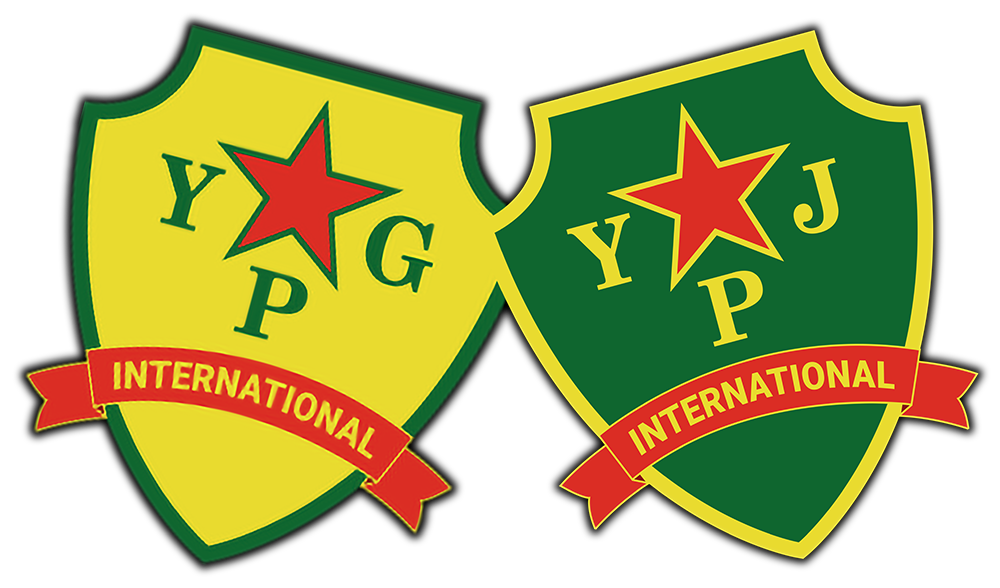Şehîd Têkoşer – Şehîd Kemal – Şehîd Avaşîn – Şehîd Hêlîn – Şehîd Şevger – Şehîd Lêgerîn
We remember our Şehîds of March
Tekoşer Piling – Lorenzo Orsetti
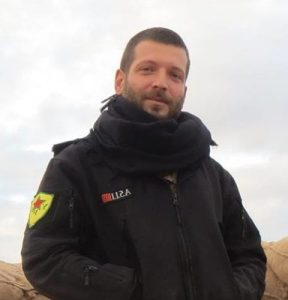 Date and Place of Birth: 13 February 1986 – Rifredi, Florence, Italy
Date and Place of Birth: 13 February 1986 – Rifredi, Florence, Italy
Date and Place of Martyrdom: 18 March 2019 – Deir ez-Zor
Lorenzo Orsetti, also known to his friends as “Orso” (Bear), was born and raised in the Rifredi district of the city of Florence, Tuscany, Italy. In his life before coming to Rojava, he worked mainly in the catering industry, first as a waiter and later as a chef.
I hope that you too one day (if you have not already done so) decide to give your life for others.
Şehîd Tekoşer
From an early age Lorenzo found himself chafing against the confines of the oppressive and barren life offered by capitalist modernity. He found the world around him akin to an open prison, where the true potential of human beings is held in check by the chains of state and capital. His idea of freedom could not be reconciled with the empty individualistic indulgences that are called freedom in the liberal society. An active anarchist and anti-fascist, Lorenzo was well-known in the squats and social centres of his home city. Although he participated in many groups, he was frustrated by the hypocrisy and half-measures of the European radical scene. As he would later say in a message from Rojava, “I hope you come to the same conclusion, because where we live, I know how difficult it is, because among comrades there’s always this kind of underlying individualism which permeates everything.” Like many others his search for liberation would soon see him drawn to the people’s revolution in Rojava, where a new paradigm of revolutionary democracy, women’s freedom and socialism was flourishing in spite of the constant attacks of many powerful enemies.
Arriving in Rojava in 2017 he took on the nom-de-guerre “Tekoşer” which means ‘one who struggles’. Although he was an anarchist, he first served with TİKKO (Liberation Army of the Workers and Peasants of Turkey), the armed wing of the Communist Party of Turkey/Marxist-Leninist (TKP-ML), a Marxist-Leninist-Maoist party. Speaking about this contradiction he said “Personally, I am an anarchist, but yes, many of them have a Marxist-Leninist base, but it’s quite different here. The ‘Democratic Confederalism’ written by Ocalan, is different in comparison to the Communism we expect – its about creating an experimental society based upon respecting diversity, trying to give dignity and bringing everyone together.” The party had joined the fight against Daesh in Kobanê in the early days of the war, and was part of the structure of the International Freedom Battalion. After fighting with TİKKO, Heval Tekoşer joined Tekoşîna Anarşîst (Anarchist Struggle), an anarchist military structure in Rojava which was newly formed in Autumn 2017. He was instrumental in the development of this new organisation. His comrades in this organisation remember him with a deep love and fondness.
In January of 2018, the Turkish state launched its attack on Afrîn ultimately ending in the occupation and subjugation of the people. Over 53 days, the revolutionary fighters held out against the onslaught of one of the great military powers of the world. The brutal bombardment of Afrîn, which caused massive damage to the city and killed hundreds of civilians, had a profound impact on Heval Tekoşer, who fought alongside his comrades to defend the city and countryside of Afrîn Canton. One comrade remembers “When I met him it was after the offensive in Afrîn…I could already see the magnitude of feelings that he had locked inside himself. When he talked about Afrîn, he would stare at the horizon and close his eyes a little when he spoke. It was still too early for Heval Tekoşer to be able to open his emotions after having participated in the battle and resistance in Afrîn. Still, he spoke of the feeling that burned inside his chest, of having lost Afrîn, he spoke of the responsibility he felt…Of the pride he felt when he remembered the comrades he had met there fighting. He lowered his head, and repeated again “we have lost Afrîn, with all the people inside…” He was silent. I didn’t know what to say. These were our first conversations. “We will be back!” he would say at the end.”
In an interview, he spoke about his experiences during the resistance in Afrîn “If you ask anyone about Afrîn, they will remember the air-strikes and the drones, because it was all air-strikes and drone bombings. Contact with the enemy? Yes, I had it. In the first month there was still a way to fight well, but in the second month it was quite difficult. They were killing people and buildings were razed to the ground. More like scorched earth, because I saw many civilians killed through bombings in Afrîn; many children, many women and many people lost their homes. It was devastating to see that nobody did anything: Russia left the airspace free to Turkey; America did not intervene. Many mistakes were made in Afrîn, but we are trying not to repeat them. We are trying to be prepared, but we are obviously not a superpower. We are revolutionary fighters, we are not a regular army. That’s why it would be terrible to see the world turn away again and pretend like nothing has happened while civilians die in the worst way possible. I saw the charred remains of people under air-strikes,” he said, his voice clearly laden with the pain he felt at these atrocities. “Anyway we are here and we will do our best.”
Heval Tekoşer also fought in the War Against Daesh. “Somehow Daesh represents an evil for me, I think for everyone it can represent a kind of absolute evil,” he said. He participated in Operation Al-Jazeera Storm, an SDF offensive to drive ISIS out of their remaining stronghold in the desert of Deir Ez-Zor. He fought in the battle for the town of Hajin. Since the fall of both Raqqa and Mosul, ISIS had been on the run, losing vast swathes of their territory in a short time. The end of the Islamic State’s regime of terror was in sight. In Hajin, the most fanatical fighters of Daesh had fortified their positions, including many of their international fighters.
“It was a very hard battle outside the desert of Hajin,” said Heval Tekoşer “It took us a long time to conquer it because it was a stronghold – very well defended. Every time we took the territory, Daesh counterattacked and we’d lose everything, meaning we had to start all over again. Many comrades died in the effort to conquer that city.”
In March 2019, he joined the fight to liberate Baghouz, the last bastion of ISIS in the Deir-Ez-Zour region. After this battle, the SDF declared that Daesh had been defeated. They did not go quietly, and the fighting was intense. Heval Tekoşer fell şehîd on 18t March when his unit was ambushed by Daesh fighters, less than a week before the final victory was declared.
After fighting with TİKKO, Heval Tekoşer joined Tekoşîna Anarşîst (Anarchist Struggle), an anarchist military structure in Rojava which was newly formed in Autumn 2017. He was instrumental in the development of this new organisation.
The body of Lorenzo Orsetti was repatriated to Italy, after a martyr’s ceremony at the Semalka border crossing between Syria and Iraq, which was attended by hundreds of comrades and supporters. A month later, he was laid to rest in his native Florence. At a ceremony to celebrate his life, his father, adorned in the red, green and yellow of Rojava, said “Lorenzo introduced us to the Kurds and Kurdistan. By now I understand better how right he was. I will continue to support the just struggle of the Kurds. Where fascism reigns, resistance shall be mounted.” His family has continued to champion the cause for which their son gave his life.
“Şehîd Tekoşer would inspire hope in the most adverse situations. Lorenzo’s heart was free therefore the land he stood on was a liberated territory. He defended it!” remembered his comrades in TKP/ML.
Kemal Brîtanî – Konstandinos “Kosta” Erik Scurfield
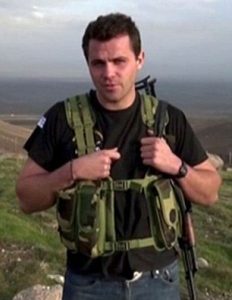
Date and Place of Birth: 22 September 1989 – Barnsley, Yorkshire, England
Date and Place of Martyrdom: 2 March 2015 – Gundê Xizêla, Til Hemis, Heseke
In 2014, Heval Kemal arrived in Kurdistan from the UK to join the YPG in their fight against ISIS and in defence of the revolution. As a former Royal Marine with 45 Commando, he brought with him valuable military experience as a fighter and combat medic.
Konstandinos Erik Scurfield was born in 1989 in North Yorkshire, England and grew up in the town of Royston, near Barnsley. The eldest of four children, he had a sister and two brothers. Named after his two grandfathers, his parents remember him as a quiet and serious young boy, who from an early age would wake up at 6am to care for his sister and make her breakfast before school. Known affectionately as Kosta by his friends and family, from an early age he was independent and strong-willed. He had a creative streak and a passion for performance, and from a young age wanted to be an actor. After leaving school, he pursued a college course in Performing Arts in Nottingham, and later spent a summer learning circus skills. Kosta was a person who was driven by a strong social conscious from a young age. He was always searching for ways to make a positive difference in the world, to help those less fortunate than him, and this search would define his path. When he was 14 he went with a group to Malealea in South Africa to participate in environmental works, where he helped to plant trees and clean out a local reservoir.
After finishing college, he decided to set off on a long walk across Europe, making his way to Greece where he was eligible for military service due to his Greek ancestry. With just a change of clothes, a small sum of money, one pair of shoes and a sleeping bag, he set off on an epic journey. His mother believes that he used this as an opportunity to reflect on his priorities. He was determined to work with aid organisations such as Halo, who specialise in landmine-removal, but found that most of them were looking for volunteers with military experience. After giving away his last money to a beggar in Italy and spending his 21st birthday in the Alps, he arrived in Greece where he spent 6 months in the army.
On his return to the UK, he joined the Royal Marines, serving in 45 Commando as a battlefield medic. Although his parents had doubts that this caring, sensitive and creative young man would find his feet in the hard life of the military, with its rigid discipline, Kosta excelled at his new work with some former comrades of his describing him as a “one-man army [who] found his true calling with the Green Berets”. Now 6’4 and an avid boxer and weightlifter, another fellow Marine described him as a “colossus of a young Marine, ruthless, but with a heart of gold”.
Life is not measured in years, its measured in deeds.
Şehîd Kemal
Although happy and successful in his new life, with the rise of ISIS and their reign of terror across Syria and Iraq, he grew increasingly frustrated by the inaction of the British government. After asking his commanding officer if the British military would be going to join the fight against ISIS, he was told “No”. His mother recalls “‘He became very frustrated that we were standing by as innocent people were being killed. […] When he was told no, he couldn’t comprehend it. He grew up on a diet of ‘Let’s save the Kurds from Saddam Hussein’ or ‘Let’s save all the women in Afghanistan from the Taliban.’ There was a constant feed of propaganda from the British government over why we went to those wars, so when he was told, ‘Oh no, we’re not going to Syria’, he was frustrated. He’s always been the kind of kid who never expected other people to do things for him: if something you want is not happening, get off your bottom and do something about it.”
In typical fashion, Kosta made up his own mind. On Christmas Day 2013, he told his mother of his plans. “Mum, I want to go to Syria and help,” he told her. “The Kurds are dying and our government’s doing nothing.”
With the unfolding massacre of the Yezidis of Sinjar by ISIS, and the beginning of the coalition air support, Kosta once again pushed his commanding officers. After being told No once again, he took action. He was arrested on his first attempt to travel to Syria by the British military, but determined as ever, he told them he was going to Syria one way or another and they’d be better off releasing him from his service. They eventually relented. He resigned from the service in September 2014, and within a few weeks he had made contact with the YPG and set out for the Middle East.
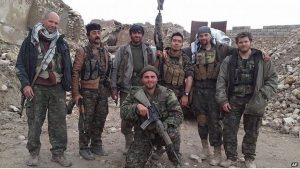 After arriving in Iraq, he joined up with Kurdish and internationalist comrades and went straight to the frontline in Sinjar, where he saw heavy fighting against the forces of the Islamic State. With his military experience, and his skills as a combat medic, Heval Kemal, as he was now known, was an invaluable part of his unit. Heval Kemal was deeply committed to the cause of the revolution and the struggle against ISIS, and he gave everything to the fight.
After arriving in Iraq, he joined up with Kurdish and internationalist comrades and went straight to the frontline in Sinjar, where he saw heavy fighting against the forces of the Islamic State. With his military experience, and his skills as a combat medic, Heval Kemal, as he was now known, was an invaluable part of his unit. Heval Kemal was deeply committed to the cause of the revolution and the struggle against ISIS, and he gave everything to the fight.
In his final Facebook post before departing for Iraq he had written a quote from German anti-fascist Sophie Scholl, who had been executed by the Nazis for her anti-war resistance. “How can we expect righteousness to prevail when there is hardly anyone willing to give himself up individually to a righteous cause. Such a fine, sunny day, and I have to go, but what does my death matter, if through us, thousands of people are awakened and stirred to action?”
One comrade who fought alongside him on the Sinjar front recalls, “We were under constant fire for a month. We were sleeping through gunfire in bombed-out buildings, 50 metres from the Isis line, moving in tunnels, running for cover every time a mortar fell. Isis attacks usually came at night. Dressed all in black, they would swarm over walls, illuminating the dark with gunfire. We were heavily outnumbered but managed to hold them back each time, aiming at their muzzle flashes. We knew that if they pushed hard enough we’d be overrun, so we agreed to not let anyone get captured; that we would die fighting together, no matter what. […] Day to day, we held our line. Kosta built a makeshift gym to keep us fit and cooked most of our meals. I have this image of him laughing while chopping frozen chickens on an Isis helmet, bombs going off in the distance. He could even make tinned meat taste good.”
One comrade recalls being saved by Heval Kemal during the fighting: “Rounds were flying everywhere when a bullet went through my thigh,” he says. “While I was fighting to stay conscious, Kosta and an American named Cudi stemmed the bleeding, loaded me on to a makeshift stretcher and carried me 300 metres under constant fire to an evacuation vehicle. If it hadn’t been for them, I would not be here today.” He remembers the last conversation he had with Kosta before he blacked out. “He was joking, asking me how it felt to be shot and if I was happy that I could go home […] The last thing I saw before I passed out was Kosta sprinting back to the frontline. I had no idea that would be the last time I saw my friend.”
After the victory against ISIS on the Sinjar front, Heval Kemal crossed into Syria and fought on the frontline of operations against Daesh in Rojava. As a skilled fighter, battlefield medic and natural leader, he was indispensable to his unit, saving many more lives and bringing great heart and commitment to the fight. In a video made two days before he fell Şehîd, as he traversed bombed out buildings with his comrades, he commented that he felt happier in Kurdistan than he had in many years. He was content with his life as a soldier and felt that fighting was his calling. Reflecting on the risk that he faced during the war, he said that “in our culture people deny death. We all know that we are going to die, but they don’t live with the knowledge of it… We have to be more in touch with death. Not scared of it.” He had fully come to terms with the risks he faced in fighting against Daesh. “You have to live for something. Die for something if needs be.”
During the operation to liberate Til Hemis, a small town near the Iraqi border east of Qamislo and Heseke, Heval Kemal was in a vehicle convoy transporting wounded fighters and refugees from the village of Xizêla. The convoy came under heavy fire from a Daesh ambush. It was during this firefight, fighting to the last minute, that Heval Kemal fell sehid on 2 March 2015. Living up to his word, he gave his life for his comrades, for the people of Syria and for the cause he believed in so deeply. “His flame might have burned briefly, but it burned brightly with love, courage, conviction and honour and we are very proud of him,” Şehîd Kemal’s parents, Vasiliki and Chris said. They spoke of their immense pride in their son and the sacrifice he made. “Kosta died fighting for every human being’s right to live freely and safely in their own country with a government of their own choice; to celebrate their own culture and language; to worship the God they choose in the way they choose; to read and speak freely; to make music, enjoy art, appreciate history, or play football [without] fear of brutal execution.”
Şehîd Kemal’s body was returned to his family following a ceremony along the Syrian-Iraqi border in which hundreds joined in remembrance and celebration of his life. He was later laid to rest in the UK. At the Greek Orthodox Church in Nottingham, hundreds of Kurdish people and other supporters gathered to pay their respects to Heval Kemal and his family. The service was attended by many prominent figures in the Kurdish Freedom Movement including PYD co-chair Salih Muslim, who said that he was “not just a Kurdish hero, but a humanitarian hero, and will go down in history as such.”
Avaşin Tekoşîn Güneş – Ivana Hoffmann
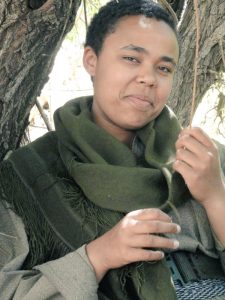 Date and Place of Birth: 1 September 1995 – Emmerich, Germany
Date and Place of Birth: 1 September 1995 – Emmerich, Germany
Date and Place of Martyrdom: 7 March 2015 – Til Temer
Heval Avaşin first came to Rojava late 2014. Born and raised in Emmerich, Germany, Ivana Hoffmann was the daughter of a German mother and a father from Togo. She came from a big family with a total of 12 siblings and half-siblings. As a youth, Ivana was actively involved in her community in Emmerich, where she played on the local football team. Friends and family remember her as being a well-liked child with many friends who loved singing, dancing and making music.
She would later move to Duisburg-Meiderich, where she lived until she came to Rojava. Here she became politically organised from a very early age, participating in the Education Strike movement in 2009. Over the next years she continued her development as a revolutionary, taking part in feminist organising, anti-fascist actions and the Blockupy Movement protests. She was also involved in actions to commemorate internationalist martyrs and to demand the freedom of political prisoners.
She joined the KGÖ (Communist Youth Organisation), the youth wing of the Marxist–Leninist Communist Party of Turkey (MLKP), a combative communist revolutionary organisation which has been engaged in struggle with the Turkish state since 1994. MLKP fighters were also among the first internationalists to lay down their lives in defense of the Rojava revolution.
In summer of 2013 she joined a delegation from the KGÖ which participated in a political youth camp and various demonstrations in Turkey. In the KGÖ, Ivana excelled as an organiser, and took on a great deal of responsibilities and tasks. In Spring 2014 she made the choice to join her comrades in the MLKP in the fight against the wave of Daesh fascism, which was spreading rapidly across Iraq and Syria. She joined the ranks of other internationalists who came to do their part to turn the tide of the war. Her keen awareness of the gender struggle, as an LGBTQ woman, steeled her in her determination to dedicate herself to the fight against the patriarchal ideology of Daesh, which they imposed with great violence wherever they gained influence.
I will be the most beautiful songs and captivate everyone. I will be a guerrilla full of love and hope.
Şehîd Avaşîn
In Kurdistan, she took the name “Avaşin”, which refers to a region of mountain ranges in Başûr, which are defended by the guerrilla forces. First she went to the mountains in the Medya Defence Zone where she received extensive political, military and language training with the guerrilla.
She was determined to develop herself as a fighter and took part eagerly in every aspect of military life. As one comrade who trained with her in the mountains remembers “She was always very eager to get to know the various weapons, disassemble them quickly, clean and maintain them. She was not content just with this. She managed to be included in our training activities such as reconnaissance, intelligence, ambush, infiltration, raid, camouflage… by persuading the commanders. Comrade Avaşin also acted as a key component in the organization of communal life, or rather in the organization of life. She was always with us, from the daily work in the kitchen, to the sentry duty, from bread-making, to the storage of dry firewood, to carry loads on the back for long distances. We were all in a struggle to rid ourselves of the habits brought by city life that hinder the guerrilla in the countryside. Comrade Avasin was also engaged in a relentless struggle with the urban habits she herself possessed. That’s why she always pushed forward against these difficulties, as well as the beauties of guerrilla life.”
She then travelled to Rojava where she went to the forefront of the fighting. “Behind us is the territory of Daesh. We’ve been here for a week. For one week we’ve been holding our position to defend the Rojava Revolution. I decided to come to Rojava because they are fighting for humanity here, for rights and for internationalism that the MLKP represents. We are here as the MLKP to fight for freedom. Rojava is the beginning. Rojava is hope.” Şehîd Avaşin speaks as she holds a position on the Til Temer front.
Şehîd Avaşin was martyred on 7 March 2015 in the village of Til Nasser on the Til Temer front during fierce fighting.
One comrade who fought at this position with her remembers the attack in which Şehîd Avaşin and her comrades fell as martyrs: “We were used to the sounds of guns and mortars, both because of the attacks and clashes in Til Temir, and because there was constant conflict around us. Just before 2am on March 7, the enemy attacked the village next to us and then our village a short time later. I woke up all the comrades along with Comrade Avasin, then she grabbed her biksî (PKM machine-gun) and rushed in the direction of the attack. Her biksî was always ready in front of her sleeping place. That was the last time I saw Comrade Avasin. She was martyred about one or two hours after the conflict broke out. Later, I learned from friends who were with Comrade Avasin on the battlefield how bravely she fought. When Comrade Avasin faced the enemy, she proved how loyal she was to the party and to her comrades to the revolution. Without hesitation, she marched against the fascist gangs and became immortal. Comrade Avasin was a young party warrior who dared to cross many borders and fight in the forefront. She became immortal, leaving a huge legacy.”
Some five thousand people attended a ceremony in her hometown of Duisburg, Germany to celebrate her life and mourn her passing. After her martyrdom, a neighborhood in Tel Temir was named in her honor.
A biography of Şehîd Avaşin was released in 2021 entitled “Ivana Hoffmann – A Life Full of Love and Hope”.
Hêlîn Qereçox – Anna Campbell
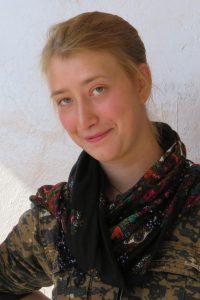
Date and Place of Birth: 12 June 1991 – Lewes, East Sussex, England
Date and Place of Martyrdom: 15 March 2018 – Afrîn
Anna Campbell was born in 1991 in Lewes, East Sussex, UK. Her mother, Adrienne was a microbiologist and her father, Dirk, was a well-known musician who has worked on many film and television productions. From a young age Anna had a strong sense of justice and freedom. She was a bookish child who would read deeply on many topics. “Most of her early interest in activism came from Adrienne,” Dirk says. “I remember in 2011, they went to a demonstration at the Houses of Parliament to commemorate the first Suffragette protest. They stormed the Houses of Parliament in Edwardian clothes.” When Anna lost her mother to breast cancer in 2012, it had a huge effect on her.
In 2010, a wave of protests spread across the UK in response to cuts to the education system by the Conservative government and other austerity measures. The student protests of that year had a particularly militant character and occupations and demonstrations were widespread, including the occupation of the Conservative Party headquarters in Millbank, London. Anna was studying in Sheffield University at the time. Her involvement in the student movement against austerity was her first real foray into the activist world and she soon made a lot of contacts across many struggles. It was not long before Anna would leave university behind and dedicate herself full-time to the anarchist, feminist and ecological causes that became the focus of her energy. “You could always rely on Anna to get things done and to be there at the heart of our organising and our struggle,” her comrades from Bristol Defendant Solidarity said about her time as an activist. “She also recognised the efforts of others which helped to support and build revolutionary community. Whether it was writing, postering, leafleting, making banners, attending court, listening to defendant’s fears and needs, organising demos or fundraisers, providing practical support to those facing trial or in prison and so much more, Anna was always there. In the face of it all, Anna often seemed to have plenty of energy and a cheery and good humoured approach to doing all she could to work for revolutionary change.”
Anna first came to Rojava in March 2017 where she joined the YPJ. Just as she arrived, in the midst of the planning of the operation to liberate Raqqa, Turkey launched a deadly air attack on the YPG/YPJ base on Mount Qereçox which martyred 20 people. Like many others who arrived she took on “Qereçox” as part of her nom-de-guerre in honour of the martyrs of the attack. She was also given the name Hêlîn (Nest) by one of her comrades in honour of a Şehîd. In Rojava, she received ideological, military and language education, and she applied herself to these studies with the same dedication she had always given to her work in the struggle. Those around her were surprised at the speed with which she picked up the language. Although she did not finish her training in time to join the fight for Raqqa, after several months of education, she went to the frontline against Daesh in Deir Ez-Zor.
I don’t want to be a şehîd. But I’m ready to.’ Why? Because a şehîd is someone who is revolutionary until the last second of their life.
Şehîd Hêlîn
When the Turkish state launched its invasion of Afrîn in January 2018, Heval Hêlîn was eager to join her comrades in the resistance. Her commanders were reluctant to let her go – several internationalist fighters had already fallen in the fight for Afrîn, and she had many talents besides her military skills. As a seasoned organiser, eloquent and articulate with an innate ability to form deep connections with all who she met, H. Hêlîn had much to bring to the revolution. But Heval Hêlîn was determined. She could not stand the idea that others would fight and die in her place. She spoke with her commanders daily and lobbied for her chance to go to the front. She gave her commanders an ultimatum: “Either I will go home and abandon the life as a revolutionary or you send me to Afrîn. But I would never leave the revolution, so I will go to Afrîn.” Another obstacle was the fact that the fighters going to Afrîn would have to pass through territory controlled by the Assad regime, and international fighters were not allowed to pass the checkpoints. With her fair skin and blonde hair, she would have a hard time blending in with the local fighters. But Heval Hêlîn was undaunted, dyeing her hair black and darkening her skin.
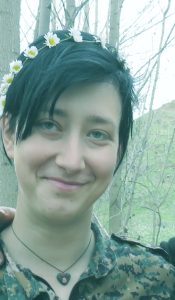 On March 15 Şehîd Hêlîn was in a position on the road out of Afrîn, covering the evacuation of civilian population from the heavy artillery and air bombardment that was raining down on the city. A Turkish air strike martyred her alongside several of her comrades.
On March 15 Şehîd Hêlîn was in a position on the road out of Afrîn, covering the evacuation of civilian population from the heavy artillery and air bombardment that was raining down on the city. A Turkish air strike martyred her alongside several of her comrades.
The death of Hêlîn Qereçox sparked a wave of protests around the world. In Bristol, where she had lived for many years, friends and comrades of hers carried out a direct action to shut down a factory of Airbus, which makes parts for the Turkish jets that killed her. The protestors explained their action: “The Bristol arms industry wants to pretend that the people it kills don’t have stories. So we have brought them the face of our friend, and the heroes who inspired her. The women of the YPJ have been critical in liberating the world from ISIS, and have been repaid with betrayal. We are here to shout their names from the rooftops. Anna Campbell, Sara Merdîn, Serhildan, Arîn Mîrkan, Barîn Kobanê, we honour you and we miss you.”
In a statement, the YPJ remembered her, saying, “Our British comrade Hêlîn Qereçox has become the symbol of all women after resisting against fascism in Afrîn to create a free world. We promise to fulfill Şehîd Hêlîn’s struggle and honour her memory in our fight for freedom.”
Her body, like many others, has yet to be recovered from the battlefield. Her father Dirk along with the rest of her family, have continued to champion the cause for which she gave her life, and led demonstrations of thousands of people demanding the return of her body. The Turkish state knows the location of her body and still refuses to release it and give some closure to her grieving family. The British government has also declined to take any action. After years of lobbying through the Turkish courts, to no avail, he has in 2022 filed a case with the European Court of Human Rights. “I would be betraying Anna’s memory if I didn’t do everything in my power to bring the Kurds’ plight to the attention of the world,” says Dirk, “Something must be done. And it needs to be done now, before anyone else’s children are killed.” Dirk would later travel to Rojava as part of a documentary about his daughter, spending time with her comrades, commanders and local people. Contemplating her loss, her sister Rose said “How could you willingly cause everyone you know so much pain? But it’s bigger than that. She’s braver than that. The world has so much going on in it and it’s bigger than our tiny pieces of grief.” Şehîd Hêlîn’s story has served as an example for revolutionaries around the world, who carry on the struggle in her memory. In particular she has become an enduring symbol of the women’s movement both in Kurdistan and abroad – her face is everywhere. Her example has inspired many to come to Rojava to join the fight against fascism. The academy of the Internationalist Commune is named in her honour.
A collection of poetry, memoirs, photos and art concerning Şehîd Hêlîn and the Rojava Revolution called, ‘IMMORTAL: Mourning, Martyrs & Murals‘ was released a year after her martyrdom by her friends and family.
Şevger “Ara” Makhno
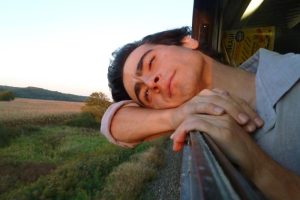 Place of Birth: Turkey
Place of Birth: Turkey
Date and Place of Martyrdom: 4 March 2018 – Afrîn
Originally from Turkey, before coming to Rojava Ara had lived for some time in Europe where friends said “he felt the individualism of the people, their loneliness.” “He prepared himself and his journey in a patient and focused way. Once he would leave, he said, it will take time to recover the ‘reflexes’ which he had lost during his stay in [the] capitalist modernity of the cities of Europe.”
Heval Şevger arrived in Rojava on 20 January 2018, just as the Turkish state and their jihadist mercenaries launched a full-scale invasion of Afrîn. There he joined the anarchist unit Tekoşîna Anarşîst. In Rojava, he took on the nom-de-guerre Şevger Makhno – Şevger meaning “nightwalker” and Makhno in memory of anarchist revolutionary leader Nestor Makhno.
One comrade reflected on his choice of name: “Şevger, one who walks in the night. I asked him what is the reason of taking this name… as far as I can remember I have never got an answer. But maybe the only true answer is the one that is being [sought]. Night is the sanctuary of life; many lifeforms including insects, mammals, fishes and birds thrive under the protection of darkness. As he walked through the land under the cover of night and under the shade of olive trees, and as he fought for life with his own life, he was indeed and truly a night walker.”
“Ara knew how to lighten up situations,” a comrade of his remembers. “His original humor brought smiles to faces through his letters, through spoken words, through touches or through a single look. He surprised his friends with care, waiting for a train of which he did not even know the time of arrival, just to welcome you on the platform, or secretly filling your pockets with almonds and other gifts, with singing a song in a moment of hopelessness.
Ara had a deep understanding of hevaltî. On his way, he always shared a feeling of connectedness, of ‘us’, being right here right now but always looking forward. Ara could take you dreaming, just to pinch you in the right moment. This is not a dream. Gain consciousness, sharpen your senses. Akilli ol [Turkish for “be smart”]. He thrived for freedom and was aware of the responsibility it brings. His strong will to be part of a revolutionary community, his understanding of trust and his courage continue to inspire us.
Thinking about Şehîd Şevger we see his adroit, witty figure, climbing to the top of the trees, carefully observing his surroundings, and moving seamlessly within the night, we still expect him to show up suddenly, a witty look in his eyes and with a çakal smile, his soul burning freedom.”
He soon began his training, where comrades recall him “constantly showing strong will”. He was eager to go to the front and join in the people’s resistance against the invasion. He joined the Antifascist Forces in Afrîn (AFFA), who described themselves as “a military group of leftist revolutionaries defending Afrîn and its people from the invasion of the Turkish state and its Salafist proxies.”
He was inspired by the tenacious resistance of the people of Afrîn against the occupation of their lands. “The will-power of the fighters in Afrîn is a huge morale and motivation for the people of Rojava, increasing their faith to the revolution, to the movement. These are those days, one of those few times where we can find ourselves in the spirit of the fight, sharing the feeling of comradeship and barricadeship… maybe our group’s presence in Efrin will not make a huge difference or will make, I’m not sure… but it is sure that the resistance in the fronts will make a huge difference on us, for us and for the future,” he wrote in a letter to his friends shortly before leaving for the front.
While defending a position near the village of Berbêne, Şehîd Şevger was martyred by a Turkish air-strike on 4 March alongside two YPG fighters. In order to protect the security of his family and loved ones, his legal identity and picture were not released for four years. On the anniversary of his martyrdom, in 2022, his comrades in Tekoşîna Anarşîst decided to release his picture to “let
the world know, how Şevger Ara Makhno looked like. We are happy to share the image of this
revolutionary with beautiful heart and wicked eyes, so that you can look into them and have a glimpse of a soul that struggled for love and freedom and made the decisions on his lifepath of an anarchist militant. Ara continues to inspire us every day.”
Lêgerîn Çiya – Alina Sanchez
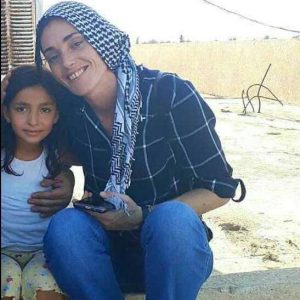 Date and Place of Birth: 4 September 1986, Argentina
Date and Place of Birth: 4 September 1986, Argentina
Date and Place of Martyrdom: 17 March 2018 – Hesekê
Alina Sanchez was born in San Martín de los Andes, Neuquén, Argentina in 1986. As a child, she had a contagious warmth and passion for other people, and a desire to help to make the world a better place. She carried this with her throughout her life. In Kurdistan, she took the name “Lêgerîn”, which means search. This search would take her to many places across the world, and defined her path in life. Echoing the journey of fellow Argentine revolutionary Che Guevara, this search took her to Cuba and to the field of medicine. Always with a keen interest in other cultures, she initially wanted to study anthropology. When a professor offered her the chance to take part in a scholarship programme to study medicine in Cuba, she seized the opportunity. In Cuba she studied to become a doctor at the Latin American School of Medicine (ELAM), an institution which was born out of the Cuban revolutionary movement. This school is focused on training doctors from economically deprived communities all over the world – even doctors from disadvantaged areas in the United States can study there if they pledge to carry on their work within poor communities.
In 2010 she was part of solidarity convoy which travelled through Chiapas, Mexico, the homeland of the indigenous Zapatista liberation movement. The convoy travelled to Panama, where they supported a protest by local farmers against neoliberal policies that were destroying their livelihoods. Police attacked the demonstrations and killed several people. Heval Lêgerîn was involved in treating the wounded there. She also spent significant time amongst the Zapatista movement in Chiapas, learning from and contributing to their struggle.
In 2011 and still in the midst of her medical education, Şehîd Lêgerîn travelled thousands of miles across the world to Kurdistan. Initially she intended to travel to India to participate in humanitarian works. However during a stay in Germany on her way there, she came into contact with the Kurdish Freedom Movement, and was deeply inspired by their struggle. She decided to go to Kurdistan, where she joined the guerrilla in the mountains of the Medya Defence Zone in Başûr. Despite nearly being martyred in her first month there, Şehîd Lêgerîn was determined to continue, and spent 5 months in the mountains weathering the terrible bombardment from the enemy forces. In a statement the PKK said “Under intense attacks by the Iranian and the Turkish state, she remained in the Qandil, Xinere and Gare regions. She witnessed first-hand the war aspect of the struggle for freedom and democracy in Kurdistan under the bombs.”
After an intense period of struggle and education in the mountains, Heval Lêgerîn decided to return to Cuba to finish her medical studies. On her way she continued revolutionary work with comrades in Europe and also visited Argentina. In 2014, with her medical studies finished, she returned to Argentina for a time. With her innate ability to connect with people and her deep understanding of the revolutionary struggle in Kurdistan, she acted as a bridge between the movement in Kurdistan and revolutionaries in Latin America. Heval Lêgerîn arrived in Rojava in Autumn 2015 and soon become an integral part of the work to build up a healthcare system that would truly serve the people. A comrade remarked “She believed that it was necessary that the whole society have the right to live a healthy life and that health was not just something that could be established just through pharmaceutics, but that instead it was much more necessary to overcome this system which is full of sickness.”
In her time in Kurdistan and beyond, Heval Lêgerîn served the people as a fighter, as a healer and as an organiser, with her unique ability to bring people together. Comrades remember her as someone who always brought enormous dedication to everything; from the large-scale social projects she championed to the mundane tasks of daily life. She was always striving to better herself and the people around her and to overcome problems and shortcomings wherever she found them. She was acutely sensitive to the topic of gendered violence and oppression and wanted to help all women to find their strength together and overcome the patriarchal society.
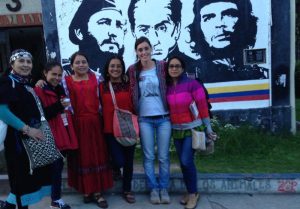 She left Kurdistan again in early 2017 and returned to Latin America. Heval Lêgerîn was immensely impressed with the ideological developments of Democratic Confederalism and saw that it offered a way forward for her continent which has been plagued by an endless cycle of violence and oppression for hundreds of years. She made great efforts to link the struggles in Latin America and Kurdistan. It was not long before she returned once again to her work in Rojava.
She left Kurdistan again in early 2017 and returned to Latin America. Heval Lêgerîn was immensely impressed with the ideological developments of Democratic Confederalism and saw that it offered a way forward for her continent which has been plagued by an endless cycle of violence and oppression for hundreds of years. She made great efforts to link the struggles in Latin America and Kurdistan. It was not long before she returned once again to her work in Rojava.
Tragically on 17 March 2018 Heval Lêgerîn fell Şehîd from a car accident in Hesekê. She has been an inspiration to many and her memory carries the revolution forward. Honouring her intense dedication in building up the healthcare system in Rojava, a hospital in Til Temer was built which carries her name.
In 2020, a new magazine project called Lêgerîn was founded, which aims to promote the ideology of Democratic Confederalism internationally, carrying on the work which Şehîd Lêgerîn championed through her years with the movement. It is currently published in English, German, French, Spanish, Portugeuse and Italian, and carries the words of Reber Apo: “Insistence on socialism is insistence on being human” as its tagline.
In 2022 a “Cuba Brigade” named in honour of Alina Sanchez was organised by Berlin-based group Interbrigadas. It began its solidarity work and educational exchange with Ventana al Valle, a socio-cultural center in Viñales in western Cuba in April. The work included planting trees, building workshops & housing, rennovating a library and building up a permaculture fruit forest.
